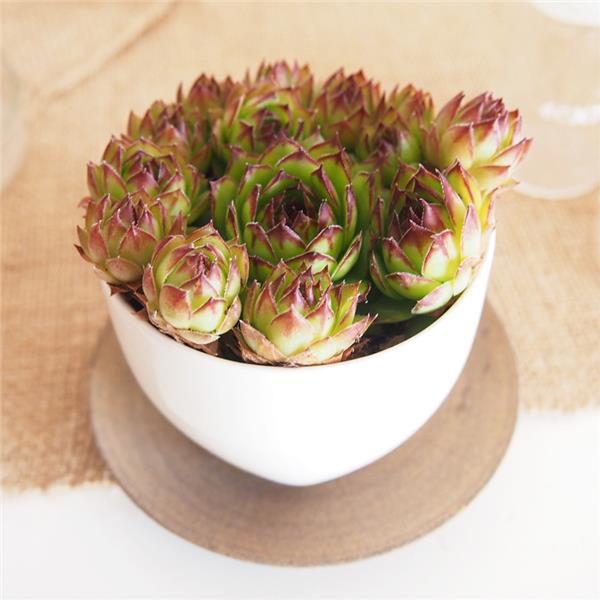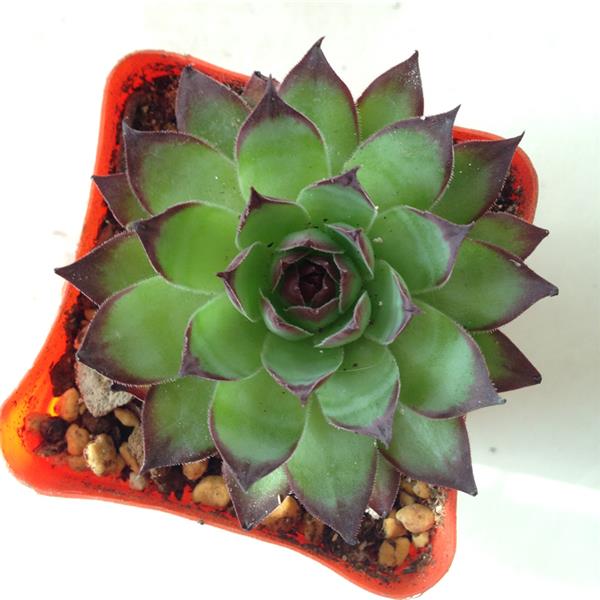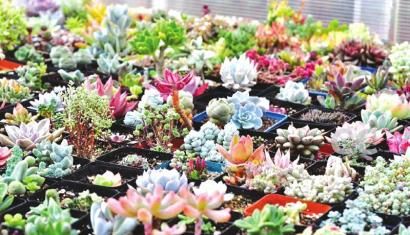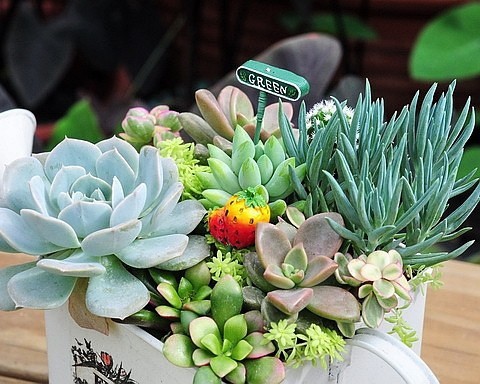The breeding method of crassulaceae Guanyinlian is it poisonous
Guanyinlian is a famous indoor culture plant in recent years, and its sales have soared because of its lotus-like throne shape, succulent texture, and amaranth appearance at the tip of its leaves. Let's take a look at the breeding method of crassulaceae Guanyinlian. Is crassulaceae Guanyinlian poisonous?

A brief introduction to Guanyinlian of sedum family
Crassulaceae Guanyin lotus plant shape is dignified, like a blooming lotus, the leaf color is varied, the purplish red leaf tip is very chic, suitable for small and medium-sized potted plants or combinations of potted plants, with different shapes of flowerpots, the ornamental effect is also very different, planted with cartoon flowerpots, lively and lovely, popular with children; planted with purple sand pots or blue and white porcelain pots, dignified and generous, quite favored by the middle-aged and elderly And planted in small wooden flowerpots, fashionable and natural, very popular with young people. The Guanyin lotus plant of crassulaceae has a rosette-shaped leaf disk with many varieties, ranging from 3 to 15 meters in diameter. The fleshy leaf spoon shape, tip tip, leaf color according to the variety, there are gray-green, dark green, yellow-green, reddish brown and other colors, the tip of the leaf is not only green, but also red or purple. At present, the more popular varieties on the market are purple leaf tips, and the leaf edges are densely serrated. Well-developed plants will bear a circle of small rosettes under the big rosette. in addition, a red walking stem similar to the orchid will be drawn from the lower part of the leaf clump at the end of spring every year, and there are rosette-like leaflets at the front end of the walking stem. The florets of evergreen grass are star-shaped and pink.

The Propagation method of Guanyinlian of Sedum
Leaf insertion: lay the complete mature leaves on the moist sandy soil with the leaves facing up and back down, without covering the soil and placing them in a cool place. Leaflets and new roots can grow from the base of the leaves in about 10 days, and the roots can be buried in the soil. In the future, let it bask in the sun, properly water and fertilize, and it will gradually grow into a strong new plant.
Cuttings: single leaves, tillering branches or top branches can be used. The cuttings cut are unlimited in length, but after the cut is dry, remove the lower leaves and insert them into the sand bed. It usually takes about 20 days to take root after insertion. Insert soil should not be too wet, otherwise the cut is easy to yellow rot, the root length of 2-3 meters on the basin. It can also be inserted with blades.
Ramet: it is best to do it in spring. Cuttings are often used to breed. Indoor cuttings can be carried out in all seasons, especially from August to October, with fast rooting and high survival rate. Cuttings can be cut with single leaves, tillers or apical branches, and the length of the cuttings is unlimited, but the cut should be dried and then inserted into the sand bed. It usually takes about 20 days to take root after insertion.
Pest control: often harmed by scab, leaf spot and root-knot nematodes, 75% chlorothalonil wettable powder 800 times can be used to control root-knot nematodes, and root-knot nematodes can be controlled with 3% carbofuran granules. Pests are harmful to black weevil and are sprayed with a 500-fold solution of 25% carbaryl wettable powder.

Is crassulaceae Guanyinlian poisonous
There are two kinds of plants called Guanyinlian, one is crassulaceae Guanyinlian, and the other is Guanyinlian of Araceae. These two kinds of Guanyinlian are poisonous and non-toxic, and Guanyinlian of crassulaceae is toxic.
Crassulaceae Guanyinlian is not poisonous, but if it is Araceae, it will be poisonous. In fact, there are many kinds of Guanyinlian bought by flower friends to watch at home. Guanyinlian is just a popular name for many kinds of plants. Generally speaking, it mainly belongs to crassulaceae and Araceae. Crassulaceae plants are non-toxic, but Araceae plants are basically poisonous.
The Guanyin lotus mentioned by Hua you belongs to a plant of the genus Sedum, which is non-toxic. This kind of "Guanyin lotus" is also known as everlasting grass, Guanyin lotus, Buddha lotus and so on. The poisonous Guanyin lotus, also known as black-leaf taro, black-leaf Guanyin lotus, is a foliage plant of the genus Amorphophallus of Araceae. In fact, the distinction between these two kinds of plants is also very simple. Crassulaceae plants have thicker leaves and better texture, while Araceae plants have thinner leaves. In addition, Araceae plants usually have succulent tubers underground, and the plant height is much higher than that of crassulaceae.

For general family planting, it is necessary to pay attention to the poisonous Guanyin lotus of Araceae, rather than the succulent plant of crassulaceae; when planting Guanyin lotus of Araceae, try to avoid planting in families with children, and pay attention to maintenance, we must prevent children and people who do not know from eating by mistake or ingestion through other channels, once eaten by mistake, the tongue and throat is swollen, vomiting and diarrhea, severe suffocation, heart paralysis. If accidental ingestion poisoning, you should immediately take egg white, batter, drink a lot of sugar water or intravenous injection of glucose saline.
The function of Guanyinlian
Guanyinlian has a slight effect on absorbing indoor toxic gases, vacuuming, sterilizing, purifying air, filtering turbid gas, and slightly increasing humidity in the room. It is emphasized again that succulent Guanyinlian only has the effect of micro-absorption of toxic gases and micro-humidification. In fact, Guanyinlian can be used as medicine to dispel wind and dehumidification, relieve pain and other effects. its main function is to treat typhoid diarrhea, rheumatism, rhinitis and all kinds of skin diseases.

After reading the contents of the above article, we all know the breeding method of crassulaceae Guanyinlian. Is it toxic? Generally speaking, Guanyinlian is easy to raise, and the effect of cultivation and decoration in a row is very good.
Care should also be taken to prevent children and people who do not know from eating by mistake or ingestion through other channels. Once eaten by mistake, the tongue and throat are swollen, vomiting and diarrhea, asphyxiation and cardiac paralysis. If accidental ingestion poisoning, you should immediately take egg white, batter, drink a lot of sugar water or intravenous injection of glucose saline.
The function of Guanyinlian
Guanyinlian has a slight effect on absorbing indoor toxic gases, vacuuming, sterilizing, purifying air, filtering turbid gas, and slightly increasing humidity in the room. It is emphasized again that succulent Guanyinlian only has the effect of micro-absorption of toxic gases and micro-humidification. In fact, Guanyinlian can be used as medicine to dispel wind and dehumidification, relieve pain and other effects. its main function is to treat typhoid diarrhea, rheumatism, rhinitis and all kinds of skin diseases.

After reading the contents of the above article, we all know the breeding method of crassulaceae Guanyinlian. Is it toxic? Generally speaking, Guanyinlian is easy to raise, and the effect of cultivation and decoration in a row is very good.
Related
- Wuhan Hospital Iron Tree Blooming Result Was Instantly Frightened by the Gardener Master
- Which variety of camellia is the most fragrant and best? Which one do you like best?
- What is the small blue coat, the breeding methods and matters needing attention of the succulent plant
- Dormancy time and maintenance management of succulent plants during dormancy
- Minas succulent how to raise, Minas succulent plant pictures
- What are the varieties of winter succulent plants
- How to raise succulent plants in twelve rolls? let's take a look at some experience of breeding twelve rolls.
- Attention should be paid to water control for succulent plants during dormant period (winter and summer)
- Watering experience of twelve rolls of succulent plants
- Techniques for fertilizing succulent plants. An article will let you know how to fertilize succulent plants.



